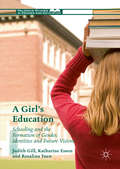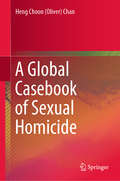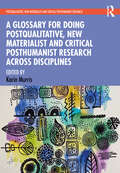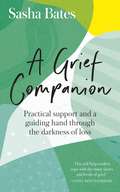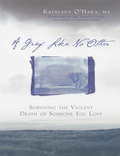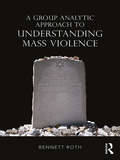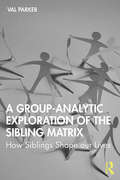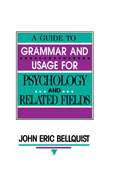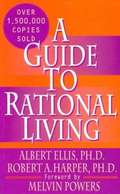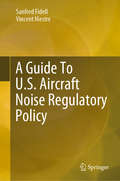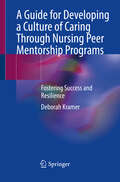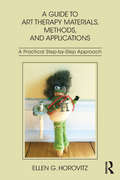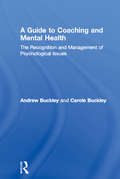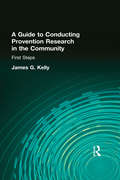- Table View
- List View
A Girl's Education: Schooling and the Formation of Gender, Identities and Future Visions (Palgrave Studies in Gender and Education)
by Judith Gill Katharine Esson Rosalina YuenThis book argues that educators and the general public have become complacent about girls' education as a consequence of the more recent fuss about problems for boys. After an analysis of persistent disquiet about girls' lifestyles, it uses theories of gender and education to demonstrate that girls are being produced in contradictory ways in current schooling. Many girls develop a sense of themselves through close connection with friendship groups but schooling processes typically require them to adopt the position of competitors in the end-of-school rankings and to act out their individualized positions in imagining themselves into the future. Ultimately the work offers insight and understanding leading to a less divisive educational pathway for girls.
A Global Casebook of Sexual Homicide
by Heng Choon ChanThis book comprehensively discusses 13 infamous cases of serial and non-serial sexual homicide committed around the globe in the past four decades (1974–2010). Offering a psycho-criminological perspective, it analyzes the cases theoretically (i.e., contributing and precipitating factors, and offender typology) and considers the practical implications (i.e., investigative and crime-preventive measures, and social services). The first book to offer a glimpse of this topic from a global perspective, it adopts a unique approach—case background and critical analysis. As such it is a valuable source of reference for scholars, clinicians, and law enforcement practitioners wanting to gain a better understanding of this type of violent offender.
A Global Perspective of Young Adolescents’ Peer Aggression and Well-being: Beyond Bullying
by Grace Skrzypiec Mirella Wyra Eleni DidaskalouReporting on the findings from a study of young people across 11 different world locations (Australia, Mainland China, Greece, India, Indonesia, Italy, Korea, The Philippines, Poland, Spain, and Taiwan), A Global Perspective of Young Adolescents’ Peer Aggression and Well-being looks beyond bullying to assess the harm to mental health and well-being of young people experiencing peer aggression in all its forms. The first book in a global movement that recommends a new dialogue on peer aggression, this book delves into the poorly understood nexus of peer aggression and bullying through the use of statistical data from questionnaires, as well as the students’ own words and illustrations. By considering data from multiple countries, it addresses critical questions about cultural variation in aggression and associated well-being. Addressing the issue that there is a growing focus on other forms of aggression other than bullying, A Global Perspective of Young Adolescents’ Peer Aggression and Well-being will offer invaluable insight for practicing teachers and school counsellors, as well as any researchers with an interest in the health and well-being of young adolescents.
A Global Portrait of Counselling Psychology
by Rodney K. Goodyear and James W. LichtenbergThe official birth of counselling psychology is said to have occurred in 1951, when key United States leaders in what was then called the field of guidance and counselling formally adopted the terms ‘counselling psychologist’ and ‘counselling psychology’ to describe their profession. In the 65 years that have followed, counselling psychology has thrived, as reflected in the fact that it now is a recognized applied psychology specialty in a number of countries worldwide. The form and expression of counselling psychology differs across countries and yet the specialty retains certain recognizable features wherever it is practiced.Drawing on data collected through a survey of professionals in eight different countries, this volume considers both ways in which the specialty is distinctive within each of the eight countries, as well as that which is characteristic of counselling psychology across them all. This survey of the international character of counselling psychology examines the emergence and the history of the field; the training, preparation and credentialing of professionals; and the practices and practice settings of counselling psychologists. This book was originally published as a special issue of Counselling Psychology Quarterly.
A Glossary for Doing Postqualitative, New Materialist and Critical Posthumanist Research Across Disciplines (Postqualitative, New Materialist and Critical Posthumanist Research)
by Karin MurrisA Glossary for Doing Postqualitative, New Materialist and Critical Posthumanist Research Across Disciplines gives novices and experienced researchers clear and comprehensible introductions to theories, paradigm shifts and key concepts in postqualitative, feminist new materialist and critical posthumanist research. The ten authors, who have a wealth of experience of teaching and conducting postqualitative research, have explored 72 key concepts and binaries. Supported by links to the series website (https://postqualitativeresearch.com/), this user-friendly glossary contains short entries of the main concepts, binaries and verbs in this field of research. The series website gives practical provocations that characterize the postqualitative terrain. Disrupting the theory/practice divide, the Glossary provides a postqualitative reimagining of traditional research processes while guiding readers through the contestation of binaries and innovative concepts. The Glossary is an accessible and introductory guide for novice qualitative researchers, and is of use to established academics already working with postqualitative approaches. It is an indispensable companion to the primary texts and original sources by theorists discussed in this and other books in the series.
A Good Apology: Four Steps to Make Things Right
by Molly HowesThrough its four essential steps, A GOOD APOLOGY gives groundbreaking advice on how best to make an effective apology toward rebuilding any relationship, for readers of The Body Keeps the Score.We've all done something wrong or made a mistake or insulted someone -- even if by accident. We've all been hurt and wanted the other person to help us heal. It may be surprising, but the breaches themselves aren't the real problem; our inability to fix them is what causes us trouble.In A Good Apology, Dr. Molly Howes uses her experiences with patients in her practice, research findings, and news stories to illustrate the power and importance of a thorough apology. She teaches how we can all learn to craft an effective apology with four straightforward steps.An apology is a small-scale event between people, but it's enormously powerful. This comprehensive book gives readers the tools to fix their relationships, make amends, and move forward. With it, you'll fully understand the meaning and importance of this universal and timeless endeavor: a good apology.
A Grace Disguised Revised and Expanded: How the Soul Grows through Loss
by Jerry L. SittserWith vulnerability and honesty, Jerry Sittser walks through his own grief and loss to show that new life is possible--one marked by spiritual depth, joy, compassion, and a deeper appreciation of simple and ordinary gifts. This 25th anniversary edition features a new introduction and two additional chapters, one which provides help for pastors and counselors.Loss came suddenly for Jerry Sittser. In an instant, a tragic car accident claimed three generations of his family: his mother, his wife, and his young daughter. While most of us will not experience such a catastrophic loss in our lifetime, all of us will face some kind of loss in life. But we can, if we choose, know the grace that transforms us.Whether your suffering has come in the form of chronic illness, disability, divorce, unemployment, crushing disappointment, or the loss of someone you love, Sittser will help you put your thoughts into words in a way that will guide you deeper into your own healing process.This revised edition of A Grace Disguised plumbs the depths of our sorrows, asks questions many people are afraid to ask, and provides hope in its answers:Will the pain ever subside?Will my life ever be good again?Will the depression ever lift?Will I ever overcome the bitterness I feel?What is God's plan in all of this?The circumstances are not important; what we do with those circumstances is. In coming to the end of ourselves, we can come to the beginning of a new life.
A Grace Disguised: How the Soul Grows Through Loss
by Gerald L. SittserIn an instant, an accident took the author's mother, wife and young daughter. How can we begin with a new life, one with joy, depth and compassion?
A Grief Companion: Practical support and a guiding hand through the darkness of loss (Languages of Loss)
by Sasha Bates'This is a book that takes you by the hand and promises the gentlest comfort in the darkest of times.' Tamsin GreigA Grief Companion offers us practical help to use alongside the theory of Sasha Bate's debut book, Languages of Loss. This guide gives us the starting points to begin our journeys of managing grief, providing us with space and pages to explore and process our feelings with Sasha's expert guidance.Sasha offers some optimism to let you know that you will find light and courage from out of this darkness, and you will be transformed by it. Your grief will not leave you, but you will arrange yourself around it differently. Split in to four sections, that can be read in any order - Mind, Body, Spirit and Everyday - this book explores the non-linear grief that you may be feeling and gives you permission to do your grief, your way. Filled with suggestions, resources, advice for friends of the bereaved and a guiding hand, we hope this book will help you see some light in the darkness of grief.'Explaining how the mind and body work together, A Grief Companion offers insights into the process of grieving. The writing is energetic, down-to-earth and honest as Sasha Bates helps readers cope with the many layers and levels of grief. A useful as well as a moving book.' Cathy Rentzenbrink, author of A Manual for Heartache
A Grief Companion: Practical support and a guiding hand through the darkness of loss (Languages of Loss)
by Sasha Bates'This is a book that takes you by the hand and promises the gentlest comfort in the darkest of times.' Tamsin GreigA Grief Companion offers us practical help to use alongside the theory of Sasha Bate's debut book, Languages of Loss. This guide gives us the starting points to begin our journeys of managing grief, providing us with space and pages to explore and process our feelings with Sasha's expert guidance.Sasha offers some optimism to let you know that you will find light and courage from out of this darkness, and you will be transformed by it. Your grief will not leave you, but you will arrange yourself around it differently. Split in to four sections, that can be read in any order - Mind, Body, Spirit and Everyday - this book explores the non-linear grief that you may be feeling and gives you permission to do your grief, your way. Filled with suggestions, resources, advice for friends of the bereaved and a guiding hand, we hope this book will help you see some light in the darkness of grief.'Explaining how the mind and body work together, A Grief Companion offers insights into the process of grieving. The writing is energetic, down-to-earth and honest as Sasha Bates helps readers cope with the many layers and levels of grief. A useful as well as a moving book.' Cathy Rentzenbrink, author of A Manual for Heartache
A Grief Like No Other: Surviving the Violent Death of Someone You Love
by Kathleen O'Hara Dr Dan Gottlieb Dr.A Grief Like No Other is the book no one wants to ever have to buy; sadly, many people continue to need it. From 9/11 to Cindy Sheehan's son - from mass tragedies like the recent London bombings to Law and Order type crimes that make the news only to be replaced by another name. As such, more people are left with the aftermath of dealing with the violent death of a loved one. It brings its own special brand of grieving since victim's families can spend years dealing with legal ramifications, guilt, and a myriad of other circumstances that don't accompany "normal" deaths. Kathleen O'Hara knows both sides of this coin. As a therapist, she has counseled hundreds of people dealing with grief. As a mother, she saw her worst fears realized when her college-aged son was brutally murdered in 1999. In the aftermath of Aaron's murder, O'Hara developed the seven stage journey that is at the heart of A Grief Like No Other. Although this is a book for those left behind in the aftermath of violence, it offers concrete and practical steps and stages, allowing family and friends safe passage through this incredibly harrowing journey.
A Grief Out Of Season: When Your Parents Divorce In Your Adult Years
by Noelle Fintushel Nancy HillardFrom the book: "This book is divided in two parts. Part I, "A Map of the Terrain," lays the groundwork, seeking to understand the underlying sources of the adult child's pain. Part II, "The Journey," focuses on the more practical issues that confront the adult child at each stage of development." The authors provided many case histories to illustrate their points. In writing this book, the author used research results, case material, and their experience in dealing with the effects of divorce on adult children. Not only is this book scholarly, it is also applicable to some readers.
A Group Analytic Approach to Understanding Mass Violence: The Holocaust, Group Hallucinosis and False Beliefs
by Bennett RothA Group Analytic Approach to Understanding Mass Violence makes an analytic examination of the enactment of genocide by Nazi Germany during World War II to explore how mass and state-sponsored violence can arise within societies and how the false beliefs that are used to justify such actions are propagated within society. Bennett Roth makes use of Bion’s concept of ‘Hallucinosis’ to describe the formation of false group beliefs that lead to murderous violence. Drawing on both group analysis and psychoanalysis, Roth explores in relation to genocide: how people form and identify with groups the role of family groups how conflict can arise and be managed how violence can arise and be justified by false beliefs how we can best understand these dysfunctional group dynamics to avoid such violence. A Group Analytic Approach to Understanding Mass Violence will be of great interest to all psychoanalysts and group analysts seeking to understand the role of false beliefs in their patients and society more generally. It will also be of interest to students and scholars of Holocaust studies programs or anyone seeking to understand the perpetration of genocide in the past and present.
A Group-Analytic Exploration of the Sibling Matrix: How Siblings Shape our Lives
by Val ParkerA Group-Analytic Exploration of the Sibling Matrix: How Siblings Shape our Lives offers a fresh approach to siblings, recognising how these relationships are embedded in the framework of the family and how sibling experiences shape our lives, influencing relationships with partners, friends and colleagues, and affecting how we take our place in groups and in society. The book is divided into three parts. Part One focuses on the sibling life cycle, exploring how these relationships shift and change throughout life according to context and circumstances. In Part Two, Parker uses clinical examples to consider how therapists working with individuals and groups might expand their thinking to incorporate the sibling matrix. The final part investigates how the sibling matrix manifests in organisational life and considers how we might develop mutuality and cooperation in our universal sibling matrix. Drawing on the author’s wealth of experience as a clinician, the book incorporates compelling personal stories and clinical examples to bring to life the realities and nuances, the good and bad, the healthy and supportive, and also the potentially damaging aspects of sibling relationships. Accessibly written, this is a rich and rewarding invitation to reflect on our own experience, whether as clinicians, researchers or as members of our own sibling matrix.
A Guidance Approach for the Encouraging Classroom
by Dan GartrellA GUIDANCE APPROACH FOR THE ENCOURAGING CLASSROOM, 5/E, is for students in two- and four-year early childhood programs as well as graduate courses. It easily can function as a primary text in classes that address group management, the learning environment, child guidance, child behavior, challenging behavior, conflict management, and peace education topics. The text addresses ages 3 - 8 years in three parts. Part 1 explores the foundation of guidance in early childhood education and covers key concepts such as conventional discipline versus guidance, mistaken behavior, the guidance tradition, and innovative theories about child development with guidance. Part 2 focuses on building and organizing an encouraging classroom, as well as providing key elements of an encouraging classroom, including daily schedule, routines, use of thematic instruction, importance of working with parents, and leadership communication. Part 3 addresses problem solving and challenging behavior in the encouraging classroom, including a practical illustration for how to use and teach conflict management and coverage of the five-finger-formula. The book also covers nontraditional families as well as the effects of societal violence in the classroom. Throughout, this experience-based resource includes real-life anecdotes that allow professionals to make the shift from conventional classroom to developmentally appropriate guidance.
A Guide To Grammar and Usage for Psychology and Related Fields
by John Eric BellquistWhy another book on this topic? The author's experience editing leading journals in psychology suggests that publication manuals and books on writing about experimentation in psychology do not adequately address grammatical usage and style. Much of the advice published for scientific writers reads as if it had been written either by English teachers for writers who do not publish in scientific fields, or by scientific writers who think that the information already available in countless handbooks on grammar and style for student writers in English classes is enough. Unfortunately, such traditional handbooks do not offer the particular sorts of commentary that scientific writers need. This book offers specific advice on a host of issues ranging from the appropriate use of abbreviations to wordiness -- and how to avoid it. Dr. Bellquist's expertise in both the English language and the language of scientific writing ideally positions him to offer guidelines on the use of the passive, the best wording for statistical presentations, and just how to describe experimental procedures, among many other topics. Complete with examples and principles to guide writing decisions, this book will assist both students and seasoned professionals in presenting their work clearly for maximum impact. This book is intended as a guide to grammar and usage for writers in scientific fields -- particularly in experimental psychology and all fields related to experimental psychology. Features of the book include: * alphabetical entries and numerous cross references on grammar, usage, and style; * numerous examples taken from scientific papers or based on actual cases; * discussions of semantic problems of grammar such as modification, predication, and statement; * and discussions of usage specific to experimental psychology, statistics, and related fields.
A Guide To Rational Living Third Edition
by Albert Ellis Robert A. HarperNew, Updated Third Edition of A Guide to Rational Living. . . An International Classic in the Field of Psychology By the creators of the most popular forms of therapy in the world: Cognitive Behavior Therapy (CT) and Rational Emotive Behavioral Therapy (REBT). Considered by Many to Be the Best Book On Psychotherapy Ever Written If you have the rigorous honesty necessary to conduct self-analysis, this book can be the most important one you have read. For although it makes no promises, it can help you more than all the other self-help books put together. Rational Emotive Behavioral Therapy can teach any intelligent person how to stop feeling miserable about practically anything. Direct, get-to-the-heart-of-the-problem methods teach you what you often do to needlessly upset yourself and what you can do, instead, to make yourself emotionally stronger. These practical, proven methods of changing your self-defeating emotions and behaviors reflect the authors' vast experience as therapists and as teachers of therapists from all over the world, and have been backed by literally hundreds of research studies. A Guide to Rational Living provides much sought-after answers for individuals with problems, and it can help everyone to feel better about themselves and to deal with their lives more effectively.
A Guide To U.S. Aircraft Noise Regulatory Policy (Springerbriefs In Applied Sciences And Technology Ser.)
by Sanford Fidell Vincent MestreAviation noise remains the primary hindrance to expansion of airport and airspace capacity in the United States. This book describes the development and practice of U.S. aircraft noise regulation, as well as the practical consequences of regulatory policy. Starting in the pre-jet transport era, the book traces the development of the modern framework for characterizing, standardizing, predicting, disclosing, and mitigating aircraft noise and its effects on airport-vicinity communities. Among other matters, the book treats noise-related consequences of the 1978 deregulation of the airline industry; prediction and mitigation of community reaction to airport noise; land use compatibility planning; recent research and industry trends; and some suggestions for potential improvements to current policy. Initial chapters describe the assumptions underlying aircraft noise regulation, and lay out the chronology of U.S. aircraft noise regulatory practice. Later chapters provide overviews of population-level effects of aviation noise, including health effects, speech and sleep interference, and annoyance. Readers will learn why predictions of the prevalence of aircraft noise-induced annoyance have systematically underestimated adverse community response to aircraft noise, and how such underestimation has complicated approval and funding of airport and airspace improvement projects. They will also learn why attempts at noise-compatible land use planning are seldom fully successful.
A Guide for Developing a Culture of Caring Through Nursing Peer Mentorship Programs: Fostering Success and Resilience
by Deborah KramerThis book describes in detail how to develop successful programs of nursing mentorship, utilizing concepts of caring that yields a strong, caring body of nurses who will be “nurse thrivers” as they find fulfilment and meaning in their professional commitment and will train others to do the same. The mentorship program is the ticket to success that many students need to complete their degree program, prevent burnout, pass the nursing NCLEX examination, and remain in the workforce after graduation. The current attrition rate in baccalaureate nursing programs is 25-50%, as is the attrition rate in the first 2 years of employment of new RN's entering the workforce. Burnout is due to a lack of care and support for helping the students navigate the rigor and demands of the nursing program. Creating a community of learners with caring and support creates an environment that fosters academic engagement and success. The unique aspect of this book is its focus on creating a caring environment to support the students; helping them develop caring skills, empathy, resilience and their own self-care; developing the skills for success beyond their educational process into the workforce. This book integrates all patterns of knowing - personal, aesthetic, empiric and ethical - and provides the missing link of peer mentorship necessary to the development of resilient, emancipated nursing students and graduates capable of working in community with others to establish cultures of care in health care. This is a must have resource for transformation of nursing education in the next century! Foreword by Dr. Margaret McClure.
A Guide for Statistical Tests and Interpretations with SPSS
by Arshia U. ZaidiA Guide for Statistical Tests and Interpretations with SPSS is designed for students taking basic and advanced courses in statistics, taking an integrative and practical approach to learning statistics. It guides students through navigating SPSS outputs and writing quantitatively, dealing with technical and substantive interpretations without resorting to complex mathematical formulae.Starting from the basics of quantitative research methods and discussing descriptive and inferential statistical tests, this book provides a unique perspective of data analysis with SPSS. It makes a conscious effort to explore the various statistical methods one can use to dissect a data set using basic or advanced statistical techniques to achieve the best outcome. It covers the practical questions that arise while doing an assignment, final paper, or thesis – showing students how to proceed to the next step in their interpretation and analysis. It will provide quantitative methodology or data analysis students with core interpretations of SPSS outputs for key statistical tests. It will also demonstrate how to select and report the key trends and patterns of the data using descriptive and inferential statistics, the requirements and/or assumptions of each test, as well as the precise language to use for reporting on each test.With SPSS screenshots and step-by-step advice, this book will be useful for all undergraduate and graduate students in the social sciences and humanities, as a supplemental textbook to provide practical guidance on moving through all steps of statistical testing and analysis.
A Guide for the Statistically Perplexed
by David L. Streiner Canadian Psychiatric AssociationDo statistics-heavy research papers give you a headache? Are you baffled by bias, confused by correlation, or flummoxed by F-tests? A Guide for the Statistically Perplexed is here to help! This book is designed to assist students, clinicians, and researchers in becoming familiar with statistical and research techniques by covering the essentials of the topic and drawing attention to many common problem areas.Inspired to write on this topic in reaction to mistakes he encountered in actual papers, David L. Streiner uses his trademark sense of humour and light-hearted style to explain complex statistical concepts in lucid, jargon-free language. Streiner delves into topics such as presenting data (or, conversely, how not to), statistical techniques, and more advanced procedures. To help readers detect problems with research design and interpretation, he details important 'CRAP' (convoluted reasoning or anti-intellectual pomposity) detectors for which they should watch out.Even those with little or no background in statistics, measurement theory, or research will come out of A Guide for the Statistically Perplexed with a new understanding and appreciation of these topics.
A Guide to Art Therapy Materials, Methods, and Applications: A Practical Step-by-Step Approach
by Ellen G. HorovitzWritten by a well-respected author and practitioner in the field of art therapy, A Guide to Art Therapy Materials, Methods, and Applications is an innovative, comprehensive text that guides readers in how to use basic to advanced art materials and methods in a wide range of clinical settings. Through the lens of both developmental stages and assessment, the book offers practical, step-by-step instructions to incorporate these materials and methods into therapeutic work with clients of all ages and populations. In addition to such classic tools as drawing, paints, pastels, and clay, coverage of materials and special topics extends beyond the existing literature to include glass, knitting, quilting, wood burning, felting, digital applications, phototherapy, byproducts, and more. Unlike previous guides, this book specifies population benefits and contraindications for each material and technique. This research-based guide for using art materials in a safe and effective manner will be a welcome resource for students, seasoned art therapists, and mental health counselors.
A Guide to Assessment for Psychoanalytic Psychotherapists
by Judy Cooper Helen AlfillePsychoanalytic psychotherapists and psychoanalysts inevitably find themselves doing assessment in their work, both in private practice and in a clinical setting such as the NHS. The authors felt a need for a book that covers this vital aspect of their work, which would be of benefit both to students in training and to practitioners. Amongst subjects covered are the nature of assessments, the setting, consultation, contraindications, and clinical examples. This title contains the distilled wisdom of over twenty years experience in the field.
A Guide to Coaching and Mental Health: The Recognition and Management of Psychological Issues (Essential Coaching Skills And Knowledge Ser.)
by Andrew Buckley Carole BuckleyIt is vital that coaches have the ability to recognise mental health problems in their clients, enabling them to make an informed decision about whether coaching is appropriate. A Guide to Coaching and Mental Health provides an indispensable introduction to the assessment of psychological issues in the context of coaching. Divided into three sections, the book covers all the legal, ethical and practical considerations. Section one, Working on the Boundary, starts by exploring the distinction between normal and abnormal behaviour. In section two, What’s Being Said, the authors introduce fictional case studies, which cover a range of possible mental health issues from mild depression and anxiety, through to psychoses and potentially life threatening problems. Section three, Categories of Mental Illness, guides the reader through the definition and management of the more common mental health problems. This accessible and jargon-free guide to identifying mental illness will prove invaluable for coaches and other related professionals, whatever their level of experience.
A Guide to Conducting Prevention Research in the Community: First Steps
by James G KellyThis provocative and useful volume is a step-by-step guide to assist professionals in implementing valid and useful community research and creating preventive interventions that have positive and lasting effects on the development of the community. The authors--including James G. Kelly, one of the fathers of prevention--offer valuable suggestions for developing community processes to assist the prevention researcher and the community in designing research that is embedded in the community. Experts focus on the topics that can help establish and sustain effective long-term working relationships with community members. Numerous examples illustrate how the collaborative working relationship can create the variety of resources that are needed to eventually implement policy changes stimulated by the research and help to sustain the impact of the research findings after the research has been completed.This exciting book illustrates how community research related to the prevention of mental illness and the promotion of mental health can be scientific and objective, as well as a positive collaboration between the research staff and community members. Focus upon community needs Emphasize educational activities to support the prevention research Identify points of policy impact before the research begins Enhance the development of social networks and social support systems for the development of competencies Provide criteria for the selection of systemic variables for the research Include reference to the multiple levels of a community which may affect the research topic Specify ways in which participants can identify and own the research topic Outline criteria for assessing the side effects of the prevention research In order to better understand the needs, values, commitments, and resources of the community in which he or she is working, the researcher is encouraged to select research topics derived from underlying community needs, educated the public about prevention, identify points of policy impact, and determine the informal social networks that enhance the development of social competencies in the community. The benefits of the collaborative relationship between prevention researchers and the community are strongly emphasized. A Guide to Conducting Prevention Research in the Community aims to guide citizens and professionals in implementing valid and useful community research and create preventive interventions that have positive and lasting effects on the development of the community.
